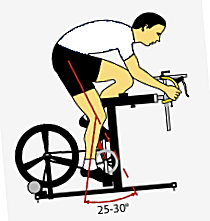Every cyclist intuitively senses how important is the seat height adjusted to the length of cyclist legs. There should be no surprise that professionals attach great importance to it, and feel just a few millimeters displacement. This type of shift may occur even when changing the cycling shoes and clothing. Indeed, the change in the bike
seat height results in a rapid change of peak power, oxygen consumption and bike riding economy. The physiological changes associated with the regulation are not permanent, but they compensate during training. This means that if we accustomed to the "too" high seat position, our muscles tend to work optimally in this setting and change to "correct" position is likely to temporarily reduce our comfort and objectively measurable aspects such as maximum power and durability. It is related to the plasticity of muscle fibers, the balance between the large muscle groups, each of which corresponds to a different angle of crank axis position, as well as the so-called plasticity of the central nervous system, which results in the generation of appropriate muscle excitation patterns . These factors are optimized to our setting.
Is there the one and only optimum, or the optimum is a setting which requires the passage of time? Well, there is biomechanically optimal
seat height. Certainly, after the initial deterioration, this will allow the maximization of power and economy of the body movements. However, it is better not to adjust the
seat height just before the competition. This should be done for more than a few weeks before the competition.
There was study performed to determine changes in the maximum power generated by the cyclist when cycling at different seat heights. Let's find out, how the difference in centimeters between the biomechanically optimum at which maximum power is achieved, and the extreme positions to 4 and -4 cm relative to this value influence the power output of the experienced bike rider.
It appears that the greatest loss of power is associated with too high seat position (+4 cm) than too low (-4 cm). The maximum recorded value of power was 981W, while 940W at the lowest point and 820W only when the
seat was 4cm too high.
 |
| picture 1 ( seat height adjustment) |
What is the seat height in the first place? There are many ways to determine the 'seat height' term, and different body measurements needs to be taken to adjust it. To begin with, we can choose the length 1 or 2 from the drawing on the picture 1. The first case does not take into account the significant length of the crank arm. Shimano offers various crank arm lengths, thus using only the first dimension may lead to erroneous results.
The second measurement (Figure 2) uses the crank arm length in further considerations, which makes that is fairly widely accepted.
Since we know the definition of
seat height, the question remains how to determine its optimum biomechanical value for a particular cyclist. The answer seems to be given by several methods for determining the correct position on the bike.
 |
| picture 2 (trochanter height/crotch height) |
This is the method of Nordeen-Snyder (1977), which determines the seat height as the number two on the drawing. According to the calculations it corresponds to 105% of the height from the ground to the greater trochanter of the cyclists femur (the distance B in the figure). It is quite difficult parameter to measure, therefore, we can use Hamley & Thomas (1967) method. It uses the height from ground to crotch (distance A in the figure) (barefoot), and the correct seat height is 109% of A.
Calculated results should be altered depending on the individual tendency to put foot on the pedal surface. If you have a manner of lifting the heel, calculated height must be increased. If, however, we like to dive heel, the
seat should be set lower than calculated.
 |
| Homes, Pruitt and Walen method |
Another method Homes, Pruitt and Walen, 1994, defines the correct height corresponding to the
seat , as the angle between the femur and lower leg, while sitting on a bike with the crank at the lowest (bottom dead centre) point. Just as described above, the position of the heel and toe, and the place of foot to pedal contact, should correspond to the most individual way of bike riding. This angle should ideally be between 25 and 30 degrees. If the angle is too big, it will not allow the muscles to work in an optimal way, with high-stretched fibers. Similarly, too small angle, with straight leg, will be exposed to large forces on the meniscus and ligaments, threatening injuries.
One of my readers correctly noted that in principle each of these measurements allows for a large differences contradicts thesis form the beginning of the article. All of the important factors, like forward
seat position, moving forwards or backwards changes the 1 and 2 length. This leads to slight, yet important deviations in biomechanics of bike riding. It is crucial to determine the seat height for a specific competitor, taking into account the habits and patterns of movement, including also all the inappropriate, individual is demonstrating.
It is difficult to choose a specific solution to an accuracy of a single millimeter. Because although incompetently performed bike fitting can distort the whole idea of this activity, it is to take into account individual habits, and with the use of widely accepted rules mentioned above, the result can give an excellent outcomes and improve the comfort, strength and endurance.
Interestingly, a lot more you can win arranging appropriate aerodynamic position, like for example known from triathlon, than just optimizing the
seat height alone. Time trial position, despite the threat of losing valuable 10 - 20 W of power, due to wrong leg angles provides a reduction in frontal area, thus about 100 W at 40 km/h gain due to less aerodynamic drag. This is something to fight for.